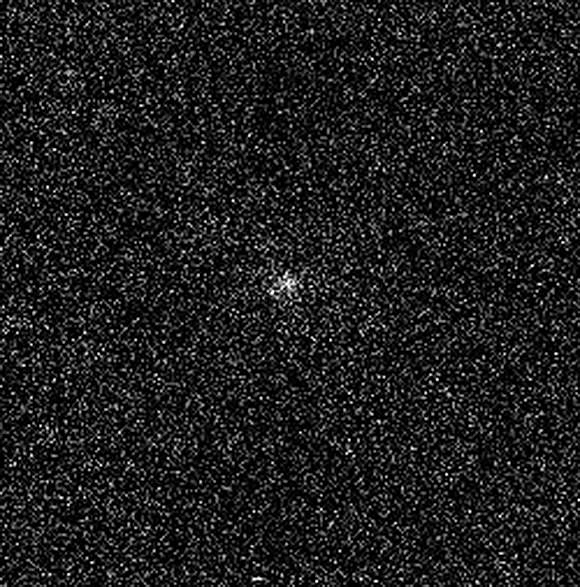It’s not much to look at, but there it is: the incoming comet ISON (aka C/2012 S1) as seen by the HiRISE camera aboard NASA’s Mars Reconnaissance Orbiter. An enlarged version of one of four just-released images, this represents a 256-by-256-pixel patch of sky imaged by HiRISE on Sunday, September 29. ISON is the fuzzy blob at center, 8.5 million miles (13.8 million km) away.
See all four images below:

HiRISE researchers Alan Delamere and Alfred McEwen explained in a news release:
Based on preliminary analysis of the data, the comet appears to be at the low end of the range of brightness predictions for the observation. As a result, the image isn’t visually pleasing but low coma activity is best for constraining the size of the nucleus. This image has a scale of approximately 8 miles (13.3 km) per pixel, larger than the comet, but the size of the nucleus can be estimated based on the typical brightness of other comet nuclei. The comet, like Mars, is currently 241 million kilometers from the Sun. As the comet gets closer to the sun, its brightness will increase to Earth-based observers and the comet may also become intrinsically brighter as the stronger sunlight volatilizes the comet’s ices.
More images of ISON from HiRISE are expected as the comet came even closer to Mars, approaching within 6.7 million miles (10.8 million km), but the illumination from those angles may not be as good.
NOTE: These are preliminary single (non-stacked) images, and still contain noise and background stars – hence the fuzziness. Plus HiRISE was not really designed for sky imaging! (Thanks to HiRISE team member Kristin Block for the info.)
So even though it’s at the “low end” of brightness predictions in these HiRISE images, ISON certainly hasn’t “fizzled” like some reports claimed earlier this year (although just how bright it will get in our skies remains to be seen.)
Comet ISON will make its closest pass of the Sun (perihelion) on November 28, 2013, coming within 724,000 miles (1.16 million km) before heading back out into the Solar System… if it survives the encounter, that is. Read more about how to view ISON here and here.
Source: University of Arizona HiRISE article by Alan Delamere and Alfred McEwen
_______________
Worried about ISON’s first (and possibly last) visit to the inner Solar System? Don’t be. Recent rumors of comet-caused catastrophe are greatly exaggerated… read more on David Dickinson’s article Debunking Comet ISON Conspiracy Theories (No, ISON is Not Nibiru).

